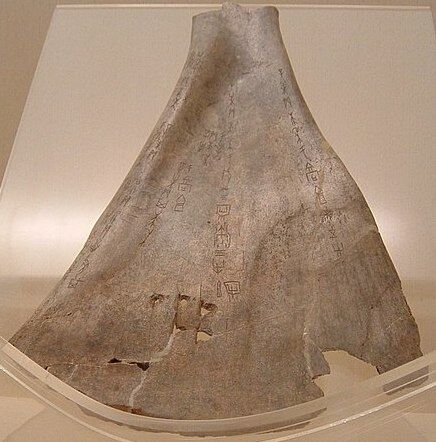Finding Evidence of Noah’s Ark—In a Single Chinese Word
Many consider it a myth. Among those who do not, numerous expeditions have been sent out to the mountains of Turkey to look for it. Yet direct physical evidence of Noah’s ark remains elusive. There have been several claims of potential discovery at several different sites, but these remain highly controversial.
Perhaps that’s unsurprising, for any wooden object from around 4,500 years ago. But the mountains of Turkey aren’t the only place where evidence of Noah’s colossal ark can be sought.
Indeed, it may be found in the tiniest of “objects”—such as a single Chinese word.
Building an Ark—Out of ‘Radicals’
The character-based Chinese language goes back at least as far as 1250 b.c.e., as recorded on bones and bronze artifacts. The squarish Chinese characters can become quite complex—made up of several “radicals,” simple individual words with individual meaning, packed together to create a new word or character.
One such example is the Chinese word for ship, or large boat. This word is made up of three parts:

Eight-person boat? It’s a remarkable parallel to the biblical story of the great ark that housed eight persons. Perhaps, like me, your first thought is wondering if it’s simply a result from the influence of missionaries or some such over the last several centuries.

It’s not. This word has been found dating to at least as early as 700 b.c.e.
Then perhaps it’s just coincidence that the ancient Chinese word for “ship” is a pastiche of words paralleling the story of the legendary ship, Noah’s ark.
If so, then the following Chinese story, traceable as far back as 3,000 years, has to likewise be coincidence. To summarize: Once there was a colossal flood that was so great it covered the mountains, killing all mankind and land-dwelling animals, save for a heroic individual named Nuwa, who built an ark that housed eight worshipers. When the floodwater finally receded, the ark landed on a mountain, and the eight individuals onboard proceeded to repopulate the Earth.

Again, this is not a biblical accounting. This is an ancient Chinese account of a catastrophic event sometime in ancient history, one which can help explain the origin of the Chinese word for “ship.” As Kui Shin Voo, Rich Sheeley and Larry Hovee write in their research paper “Noah’s Ark Hidden in the Ancient Chinese Characters”:
The ancient Book of Documents (Shu Jing), written around 1000 b.c., describes a gigantic flood so huge that it rose to heaven and drowned all the mountains and living things. The original ancient Chinese texts were destroyed by various emperors over time when they felt threatened by them, most notably the Emperor Qin Shi Huang in 200 b.c. Hence, most ancient Chinese history and legends are the compilations of people’s recollections by historians such as Confucius and Si Ma Qian. If the story of the flood recorded in Shu Jing is authentic, we reason that analysis of ancient Chinese characters which can be traced back to around 2500 b.c. ought to reveal such a story.
Their research proceeds to analyze just that with regard to the Chinese word for “ship,” and many more besides, tracing the earliest development of the individual Chinese characters and how they remarkably relate to the biblical account. (You can read their article here.)
But “coincidences” with ancient Chinese history are only the tip of the iceberg. Because similar stories can be found literally all over the globe among scattered cultures and civilizations: Celtic flood myths, African flood myths, Pacific flood myths, ancient American flood myths, sanguine Nordic blood-deluge myths.

Such stories include a central Greek flood account dating to at least the first millennium b.c.e.; a Babylonian tablet documenting the same, including the biblical parallel of animals entering the ark two-by-two, dating back to around 1800 b.c.e.; a Sumerian “Epic of Gilgamesh,” traceable in fragmentary tablets as far back as 2000 b.c.e., likewise paralleling the biblical account in many respects, right down to the release of a dove and raven at the end of the story, to see if the floodwaters had subsided. (For more on these discoveries, see our article “The Great Flood: Just a Bible Story?”)
In his article “Why Does Nearly Every Culture Have a Tradition of a Global Flood?”, John Morris, Ph.D., described his collection and analysis of more than 200 accounts around the world of an ancient flood event, originally reported by anthropologists, ethnologists and missionaries. He wrote:
While the differences [between the accounts] are not always trivial, the common essence of the stories is instructive, as compiled below:
- Is there a favored family? 88%
- Were they forewarned? 66%
- Is flood due to wickedness of man? 66%
- Is catastrophe only a flood? 95%
- Was flood global? 95%
- Is survival due to a boat? 70%
- Were animals also saved? 67%
- Did animals play any part? 73%
- Did survivors land on a mountain? 57%
- Was the geography local? 82%
- Were birds sent out? 35%
- Was the rainbow mentioned? 7%
- Did survivors offer a sacrifice? 13%
- Were specifically eight persons saved? 9%
Morris concluded with the following perspective:
The only credible way to understand the widespread, similar flood legends is to recognize that all people living today, even though separated geographically, linguistically and culturally, have descended from the few real people who survived a real global flood, on a real boat which eventually landed on a real mountain. Their descendants now fill the globe, never to forget the real event.
And as shown by the smallest of Chinese characters, maybe waiting on evidence of an ark on a mountain for “proof” isn’t the only option. Maybe, in an all-too-human problem, we “can’t see the forest for the trees.” Maybe the evidence is all around us.